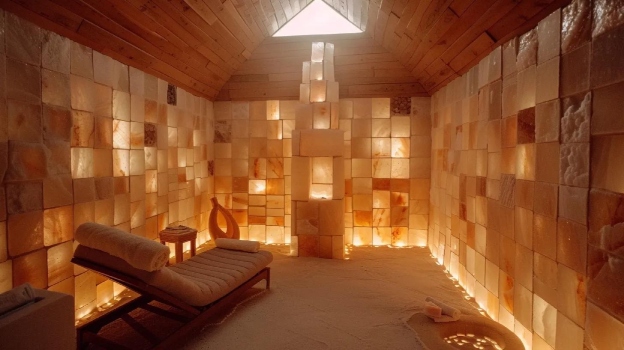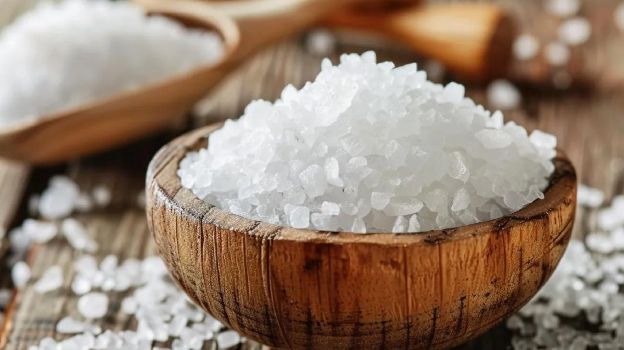Salt rooms are becoming popular because they provide natural respiratory relief and stress reduction without medications. The global salt therapy market reached $7.87 billion in 2024 and grows at 9.25% annually. Over 675 facilities worldwide now offer halotherapy services.
This wellness trend appeals to people seeking drug-free solutions for breathing problems, skin conditions, and stress management. Modern salt rooms recreate the healing environment found in ancient salt mines. The demand for natural wellness solutions drives more spas, fitness centers, and healthcare facilities to add salt therapy services.
People choose salt rooms over traditional treatments because they offer a relaxing experience while addressing health concerns. Sessions combine therapeutic benefits with stress relief in peaceful environments designed for healing and restoration.
What Are Salt Rooms and How Do They Function?
Salt rooms are enclosed spaces that disperse microscopic salt particles into the air for therapeutic purposes. These facilities contain tons of Himalayan salt covering walls, floors, and ceilings. A halogenerator machine breaks pharmaceutical-grade salt into particles smaller than 3 microns.
Active salt rooms use halogenerators to circulate healing salt particles throughout the space. The machines grind pure salt and distribute it evenly through ventilation systems. Passive salt rooms contain decorative salt without therapeutic particle distribution, serving primarily as meditation spaces.
Salt therapy sessions typically last 45 minutes for optimal therapeutic benefit. Clients breathe salt-saturated air while relaxing in anti-gravity chairs, zero-gravity recliners, or lying on specialized salt beds. The controlled environment maintains specific humidity and temperature levels for maximum comfort.
Professional salt room installations require proper ventilation, climate control, and specialized equipment. The design process involves careful planning to create therapeutic environments that meet safety standards and deliver consistent results.
Modern salt rooms feature ambient lighting, comfortable seating, and sound systems playing relaxing music. Some facilities offer private sessions while others accommodate groups of 6-12 people. The atmosphere promotes deep relaxation and stress reduction alongside physical health benefits.
How Does Salt Therapy Work in the Human Body?
Salt particles enter the respiratory system and remove mucus, bacteria, and inflammation from airways. The microscopic particles travel to the smallest airways called alveoli and bronchioles. Salt's antibacterial properties kill harmful microorganisms in lung tissue while reducing inflammatory responses.
Salt acts as a natural mucolytic agent, meaning it thins sticky mucus so people can expel it more easily. The particles also reduce inflammation in airways and improve oxygen intake capacity. This process helps people breathe more deeply and comfortably.
Skin benefits occur when salt particles land on the body surface during sessions. Salt removes dead skin cells through gentle exfoliation and draws moisture to healthy tissue underneath. The antimicrobial properties help reduce acne-causing bacteria and calm skin irritation.
The negative ions generated by salt particles may improve mood and energy levels. These ions occur naturally near oceans and waterfalls, creating the refreshing feeling people experience in those environments. Salt rooms recreate this natural phenomenon indoors.
Regular salt therapy sessions create cumulative benefits in the respiratory and immune systems. The therapy supports the body's natural healing processes without introducing foreign substances or chemicals.
Why Are Salt Rooms Growing So Fast Across America?
Salt room popularity grows because people want natural health solutions and respiratory wellness became a priority after recent global health concerns. The wellness industry reached $6.3 trillion globally in 2023, with salt therapy representing a rapidly expanding segment within this massive market.
The trend toward preventive healthcare drives consumer interest in therapies that maintain health rather than just treat disease. Salt therapy fits this model by supporting respiratory function and immune system strength through regular sessions.
Key growth drivers include increased respiratory health awareness, natural treatment preferences over pharmaceutical options, and growing acceptance of complementary medicine. Healthcare providers increasingly recognize salt therapy as a valuable adjunct treatment for various conditions.
The Salt Therapy Association reports members in 61 countries, with North America leading market growth. Asia Pacific shows the fastest expansion rates as awareness spreads globally. European countries have long embraced salt therapy, with many offering it through national healthcare systems.
Business owners find salt rooms attractive because they require minimal staffing and have low operating costs once installed. The high profit margins and growing demand make them excellent additions to existing wellness businesses or standalone ventures.
Consumer testimonials and word-of-mouth marketing drive much of the growth. People who experience benefits often recommend salt therapy to friends and family members with similar health concerns.
What Health Conditions Do People Treat with Salt Therapy?
Salt therapy helps respiratory conditions, skin problems, and stress-related symptoms based on clinical research and user reports. Medical studies show benefits for asthma, chronic bronchitis, allergies, and various skin conditions.
Respiratory conditions commonly treated include:
- Asthma affects 25 million Americans according to CDC data
- Chronic obstructive pulmonary disease (COPD) symptoms
- Seasonal allergies and chronic sinus congestion
- Common cold symptoms and recurring ear infections
- Bronchitis and other inflammatory airway conditions
Skin conditions that show improvement include:
- Eczema and atopic dermatitis
- Psoriasis plaques and scaling
- Acne breakouts and skin inflammation
- Dry skin and dermatitis symptoms
A 2017 Israeli study found halotherapy improved bronchial constriction in asthmatic children. Multiple European studies document anti-inflammatory effects in chronic bronchitis patients. Research from Finland showed reduced bronchial hyperresponsiveness in asthmatics after salt chamber treatments.
Stress and wellness benefits include:
- Reduced anxiety and improved mood
- Better sleep quality and duration
- Enhanced relaxation and stress relief
- Improved overall sense of well-being
People also use salt therapy for general wellness maintenance, athletic recovery, and immune system support. The therapy appeals to those seeking natural approaches to health optimization.
Who Uses Salt Rooms Most Often in Today's Market?
Individual consumers represent the largest user segment, followed by commercial wellness facilities and healthcare providers. People aged 25-55 make up 70% of salt therapy clients, with growing interest among seniors and parents of children with respiratory conditions.
Parents frequently bring children with asthma, allergies, or recurring respiratory infections for regular sessions. Many report reduced medication needs and fewer sick days after consistent salt therapy treatments.
Athletes use salt rooms for recovery and performance enhancement. Professional sports teams integrate halotherapy into training protocols for respiratory health and stress management. The anti-inflammatory effects may help reduce exercise-induced inflammation, which is why many fitness clubs should offer salt therapy for athletes.
Senior living communities add salt rooms as health amenities for residents. Over 40% of people aged 65+ experience chronic respiratory conditions according to National Institute on Aging research. Salt therapy provides a gentle, drug-free option for managing age-related breathing difficulties.
Healthcare providers refer patients to salt therapy facilities as complementary treatment. Pulmonologists, allergists, and dermatologists increasingly recognize the potential benefits for their patients' conditions.
Wellness enthusiasts visit salt rooms regularly for stress relief and general health maintenance. These clients often combine salt therapy with other wellness activities like yoga, massage, and meditation.
What Types of Salt Room Experiences and Equipment Exist?
Salt rooms offer group sessions, private booths, and individual salt beds using various equipment configurations. Traditional salt caves accommodate 6-12 people per session in community-style settings. Private salt booths provide intimate experiences for 1-2 clients seeking personalized treatment.
Salt beds offer 20-minute individual treatments with maximum salt exposure. These enclosed units concentrate salt particles around the client's body for intensive therapy sessions. The shorter duration makes them convenient for busy schedules.
Equipment options include:
- Standard halogenerators for room-based therapy
- Salt FX systems for larger commercial spaces
- Salt FX Pro models for high-volume facilities
- Portable units for mobile therapy services
Multi-sensory experiences combine salt therapy with complementary treatments. Red light therapy enhances skin benefits while sound therapy promotes deeper relaxation. Some facilities offer yoga classes, meditation sessions, or massage therapy in salt-infused environments.
Home salt therapy options bring treatment to residential settings. Personal halogenerators cost $1,000-3,000 and provide daily access to therapy. Home units work well for families with multiple members needing regular treatment.
Commercial facilities often feature multiple room sizes and configurations. Large group rooms accommodate yoga classes or corporate wellness sessions. Medium rooms serve small groups or families. Private rooms offer individual or couples experiences.
The wellness suite concept combines salt therapy with other modalities in comprehensive treatment packages. These integrated approaches appeal to clients seeking holistic wellness experiences.
How Much Does Salt Therapy Cost and What Affects Pricing?
Salt therapy sessions cost $25-60 per visit with package discounts and membership options available. Individual sessions average $45 for 45 minutes, with regional variations based on local market conditions and facility amenities.
Monthly membership packages range from $100-150 and typically include 4-6 sessions plus discounts on additional visits. Annual memberships offer greater savings for regular users.
Package pricing structures include:
- 4-session packages cost $150-200 (10-15% savings)
- 8-session packages offer 15-20% discounts
- 12-session packages provide 20-25% savings
Premium facilities charge higher rates for luxury amenities, private rooms, or multi-sensory experiences. Basic community-style sessions cost less but still provide therapeutic benefits.
Commercial facilities report 60-70% profit margins on salt therapy services after initial equipment investment. Low operating costs make salt rooms attractive business additions for spas, wellness centers, and healthcare facilities.
Factors affecting pricing include:
- Geographic location and local market rates
- Facility amenities and atmosphere quality
- Session duration and group size
- Additional services or treatments included
- Equipment quality and maintenance standards
Insurance coverage remains limited but some flexible spending accounts accept salt therapy expenses. As research evidence grows, more insurance providers may consider coverage for specific medical conditions.
What Does Current Scientific Research Say About Salt Therapy?
Clinical studies show salt therapy reduces inflammation and improves mucus clearance in respiratory conditions, though more research is needed. The American Lung Association acknowledges potential benefits for breathing difficulties while noting the need for additional rigorous studies.
A 2022 review of 13 studies found halotherapy improved lung function and quality of life in chronic respiratory diseases. However, researchers emphasize that more randomized clinical trials are needed to establish definitive treatment protocols.
Dr. Norman Edelman from the American Lung Association states salt particles may thin mucus and make breathing easier. Salt's antimicrobial properties fight respiratory infections naturally without pharmaceutical side effects.
Research findings include:
- Reduced bronchial hyperresponsiveness in asthmatics
- Improved mucociliary clearance in chronic bronchitis
- Anti-inflammatory effects in respiratory tissues
- Enhanced quality of life scores in chronic conditions
Eastern European countries have conducted extensive research on halotherapy for decades. Russian and Polish studies document benefits for various respiratory and skin conditions, though study methodologies vary in quality.
Recent studies focus on salt therapy's effects on exercise-induced asthma, seasonal allergies, and chronic sinusitis. Preliminary results suggest benefits, but larger controlled trials are needed for definitive conclusions.
The lack of standardized treatment protocols affects research consistency. Different facilities use varying salt types, particle sizes, and session durations, making study comparisons difficult.
Are There Any Side Effects or Safety Concerns?
Salt therapy side effects include temporary coughing and mild throat irritation as the respiratory system expels loosened mucus and debris. These effects typically occur during the first few sessions and resolve as the body adapts to treatment.
Most people experience no adverse reactions during or after salt therapy sessions. The treatment is drug-free and non-invasive, making it suitable for most age groups and health conditions.
Potential side effects include:
- Temporary increased coughing (normal and beneficial)
- Mild throat or nasal irritation
- Slight skin tingling sensation
- Increased thirst from salt exposure
People with severe heart conditions, kidney disease, or acute respiratory infections should consult doctors before beginning salt therapy. Pregnant women typically receive medical clearance as a precaution.
Salt therapy does not interact with medications or interfere with other treatments. Clients can continue their prescribed medications while receiving complementary salt therapy benefits.
Safety considerations include:
- Proper facility ventilation and air filtration
- Regular equipment maintenance and cleaning
- Pharmaceutical-grade salt usage only
- Trained staff supervision during sessions
Children over 6 months can safely participate in salt therapy with proper medical guidance. Pediatric sessions may use shorter durations and lower salt concentrations. Many parents wonder if children can use salt therapy and find it beneficial for respiratory conditions common in childhood.
How Often Should People Use Salt Rooms for Best Results?
People with chronic conditions benefit from 3-4 weekly sessions for 6-8 weeks to establish therapeutic levels. General wellness maintenance requires weekly visits, while acute symptoms respond to daily sessions until improvement occurs.
The Salt Therapy Association recommends consistency for cumulative benefits. Single sessions provide temporary relief while regular use creates lasting improvements in respiratory function and overall health.
Treatment frequency depends on condition severity, individual response, and treatment goals. Most people notice initial benefits within 3-5 sessions, with maximum benefits developing over 2-3 months of regular use.
Recommended schedules include:
- Chronic conditions: 3-4 sessions weekly for 6 weeks
- Maintenance therapy: 1-2 sessions weekly ongoing
- Acute symptoms: Daily sessions for 7-10 days
- Seasonal support: 2-3 sessions weekly during high-symptom periods
Athletes may use salt therapy 2-3 times weekly during training seasons for recovery and performance benefits. The anti-inflammatory effects may help reduce exercise-induced respiratory stress.
Some people prefer intensive treatment periods followed by maintenance schedules. Others maintain consistent weekly sessions year-round for optimal health benefits.
Response times vary among individuals based on age, health status, and condition severity. Younger people and those with milder symptoms typically respond faster than older adults or those with severe chronic conditions.
What Business Opportunities Exist in the Salt Therapy Industry?
Salt therapy businesses show strong profitability potential with growing consumer demand and multiple revenue streams. The industry offers opportunities for standalone facilities, add-on services to existing businesses, and franchise operations.
Existing wellness businesses can integrate salt rooms as complementary services. Spas, fitness centers, yoga studios, and chiropractic offices successfully add salt therapy to increase revenue and client retention.
Business models include:
- Standalone salt therapy centers
- Spa and wellness center additions
- Medical office integrations
- Mobile salt therapy services
- Home equipment sales and service
Franchise opportunities exist through established brands offering turnkey solutions, training, and ongoing support. Independent operators can develop unique concepts combining salt therapy with other wellness modalities.
Corporate wellness programs increasingly include salt therapy as employee health benefits. Companies install on-site facilities or partner with local providers for employee access.
The equipment financing options make business entry more accessible. Many providers offer lease programs and flexible payment terms for qualified buyers.
Success factors include:
- Proper market research and location selection
- Quality equipment and professional installation
- Staff training and customer service excellence
- Effective marketing and community outreach
- Consistent service delivery and facility maintenance
Understanding how to start a salt cave business requires careful planning and knowledge of industry best practices.
The industry's growth trajectory suggests continued expansion opportunities as awareness increases and research validates therapeutic benefits.
How to Choose the Right Salt Room Facility?
High-quality salt rooms use pharmaceutical-grade salt, proper halogenerators, and maintain clean, comfortable environments. Facilities should demonstrate knowledge of salt therapy principles and employ trained staff who understand treatment protocols.
Look for facilities using certified halogenerators rather than just decorative salt installations. Active therapy requires proper equipment to disperse therapeutic particles effectively throughout the treatment space.
Quality indicators include:
- Certified halogenerator equipment
- Pharmaceutical or food-grade salt usage
- Clean, well-maintained facilities
- Trained staff with therapy knowledge
- Positive client reviews and testimonials
Ask about salt types, particle sizes, and session protocols. Professional facilities should explain their equipment, salt sources, and treatment approaches clearly.
Visit facilities before booking to assess cleanliness, atmosphere, and staff professionalism. Quality operations maintain comfortable temperatures, proper ventilation, and relaxing environments.
Check for proper licensing, insurance, and health department compliance. Legitimate businesses maintain required permits and follow local health regulations.
Consider convenience factors like location, scheduling flexibility, and parking availability. Regular treatment requires easily accessible facilities with convenient appointment times.
What Future Trends Are Emerging in Salt Therapy?
Salt therapy innovations include technology integration, combination treatments, and expanded applications for various health conditions. The industry continues evolving with new equipment designs, treatment protocols, and service delivery methods.
Smart technology integration allows personalized treatment adjustments based on individual needs and responses. Automated systems can modify particle density, session duration, and environmental conditions.
Emerging trends include:
- AI-powered treatment customization
- Combination therapy protocols
- Mobile and portable solutions
- Telehealth integration for remote monitoring
- Specialized applications for specific conditions
Research into salt therapy applications for mental health, cognitive function, and athletic performance expands treatment possibilities. Studies investigate benefits for anxiety, depression, and stress-related disorders.
The integration of salt therapy with other wellness modalities creates comprehensive treatment approaches. Salt therapy for holistic health combines multiple therapeutic elements for enhanced benefits.
Final Thoughts
Salt rooms grow popular because they offer natural, evidence-based health benefits without pharmaceutical side effects. The $19.05 billion projected market size by 2034 reflects strong consumer demand for drug-free wellness solutions.
This ancient therapy now serves modern health needs through sophisticated equipment and professional facilities. People choose salt rooms for respiratory relief, skin improvement, and stress reduction in comfortable, spa-like environments.
The combination of therapeutic benefits, relaxation, and natural healing appeals to health-conscious consumers seeking alternatives to traditional medical treatments. As research continues and awareness grows, salt therapy will likely become increasingly mainstream.
Visit our gallery to explore professional salt room installations and see the variety of designs possible. Learn about our comprehensive services for businesses interested in adding salt therapy to their wellness offerings. Contact our team to discuss how salt therapy can benefit your health or business goals.






